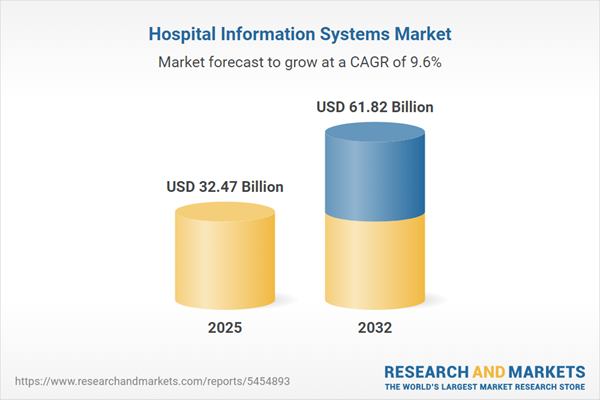Speak directly to the analyst to clarify any post sales queries you may have.
The Hospital Information Systems Market is evolving as healthcare organizations adopt digital platforms to streamline patient care and optimize operational performance. Modern hospital information systems enable efficient data flow, support regulatory compliance, and enhance clinical collaboration for improved organizational outcomes.
Market Snapshot: Hospital Information Systems Market Growth and Opportunities
The Hospital Information Systems Market grew from USD 29.74 billion in 2024 to USD 32.47 billion in 2025. With a projected CAGR of 9.57%, it is estimated to reach USD 61.82 billion by 2032. This growth underscores the increasing demand for advanced solutions that integrate patient records, optimize workflows, and support interoperability across healthcare settings. Hospitals, clinics, and research institutions are accelerating digital transformation efforts, leveraging both software and hardware innovations to support data-driven clinical efficiency and operational excellence.
Scope & Segmentation: Comprehensive Breakdown for Strategic Decision-Making
- Component: Hardware (servers, workstations), Services (consulting, implementation, training & support), Software (administrative information systems, clinical information systems, patient software applications)
- Type: Integrated, Standalone
- Healthcare Facility Size: Large-sized facilities, Medium-sized facilities, Small-sized facilities
- Application: Clinical workflow management (electronic health records, patient monitoring, telemedicine solutions), Operational workflow management (billing & revenue cycle management, inventory management systems)
- Deployment Model: Cloud-based, On-premise
- End User: Academic & research institutions, Clinics, Hospitals
- Geographical Coverage: Americas (United States, Canada, Mexico, Brazil, Argentina, Chile, Colombia, Peru), Europe, Middle East & Africa (United Kingdom, Germany, France, Russia, Italy, Spain, Netherlands, Sweden, Poland, Switzerland, United Arab Emirates, Saudi Arabia, Qatar, Turkey, Israel, South Africa, Nigeria, Egypt, Kenya), Asia-Pacific (China, India, Japan, Australia, South Korea, Indonesia, Thailand, Malaysia, Singapore, Taiwan)
- Major Companies Analyzed: 3M Company, Connexall (GlobeStar Systems), Dedalus S.p.A., Epic Systems, GE Healthcare, Hisp Info Systems, Hitachi Medical, IBM, IQVIA, Philips, McKesson, MEDHOST, Meditab Software, Mindpool Technologies, MMI Softwares, Napier Healthcare, NextGen Healthcare, Oracle, SAP, Siemens Healthineers, Smartsheet Inc., Steris Corp., Veradigm, Wipro, Agfa-Gevaert, Carestream Health
Key Takeaways: Strategic Insights for Senior Decision-Makers
- Hospital information systems are central to digital transformation, integrating patient data, administrative functions, and care delivery within unified platforms.
- Interoperability, artificial intelligence, and cloud technologies are reshaping solution design, enabling predictive analytics, secure information exchange, and scalable deployments.
- Segment-specific needs, such as cloud-based deployments for rapid scalability or standalone solutions for niche applications, drive investment choices across facility sizes and healthcare settings.
- Regulatory compliance and evolving security requirements remain crucial, influencing system architectures and vendor selection criteria.
- Vendor innovation is marked by new modules, patient engagement enhancements, and ecosystem partnerships, shaping competitive positioning within global and regional markets.
Tariff Impact: Navigating United States Policy Changes
Forthcoming United States tariffs in 2025 are expected to increase capital expenditures associated with imported hardware components such as servers and workstations. Healthcare organizations may reevaluate procurement strategies, shift to leasing models, or consider domestic alternatives. For solutions providers, impacts could be indirect, prompting price adjustments in subscription fees or implementation services. Accelerated cloud adoption emerges as a strategic response for organizations seeking to minimize risk from evolving trade policies and streamline infrastructure investments.
Primary Keyword: Hospital Information Systems Market Methodology & Data Sources
Primary interviews with hospital executives, IT leaders, and procurement specialists inform qualitative and quantitative insights. Extensive secondary research includes industry reports, regulatory filings, and vendor publications. Rigorous data triangulation, SWOT assessments, and segmentation analyses ensure robust, actionable findings.
Why This Report Matters: Tangible Value for Healthcare Leaders
- Enables data-driven investment decisions aligned with evolving technology, regulatory mandates, and operational priorities.
- Clarifies regional and segment-specific adoption trends, equipping organizations to benchmark and tailor implementation strategies.
- Informs vendor selection and contracting with up-to-date insights on competitive positioning and innovation cycles.
Conclusion
Senior decision-makers leveraging this analysis can confidently advance digital transformation in hospital information systems. Actionable recommendations and comprehensive segmentation equip organizations to navigate disruption, optimize value, and achieve sustained operational excellence.
Additional Product Information:
- Purchase of this report includes 1 year online access with quarterly updates.
- This report can be updated on request. Please contact our Customer Experience team using the Ask a Question widget on our website.
Table of Contents
3. Executive Summary
4. Market Overview
7. Cumulative Impact of Artificial Intelligence 2025
Companies Mentioned
The companies profiled in this Hospital Information Systems market report include:- 3M Company
- Connexall, GlobeStar Systems Inc.
- Dedalus S.p.A.
- Epic Systems Corporation
- GE Healthcare
- Hisp Info Systems Private Limited
- Hitachi Medical Corporation
- International Business Machines Corporation
- IQVIA Inc.
- Koninklijke Philips N.V.
- McKesson Corporation
- MEDHOST, Inc.
- Meditab Software Inc.
- Mindpool Technologies Limited
- MMI Softwares Pvt Ltd.
- Napier Healthcare Solutions Pte. Ltd.
- NextGen Healthcare, Inc.
- Oracle Corporation
- SAP SE
- Siemens Healthineers AG
- Smartsheet Inc.
- Steris Corp.
- Veradigm Inc.
- Wipro Limited
- Agfa-Gevaert NV
- Carestream Health, Inc.
Table Information
| Report Attribute | Details |
|---|---|
| No. of Pages | 197 |
| Published | November 2025 |
| Forecast Period | 2025 - 2032 |
| Estimated Market Value ( USD | $ 32.47 Billion |
| Forecasted Market Value ( USD | $ 61.82 Billion |
| Compound Annual Growth Rate | 9.5% |
| Regions Covered | Global |
| No. of Companies Mentioned | 27 |









